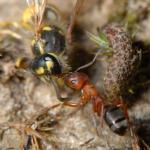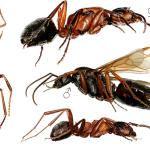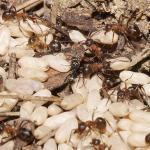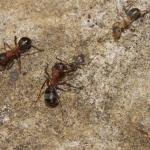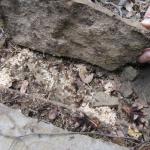This is one of eleven British ant species in the genus Formica but it is the only one of the sub-genus Raptiformica. This is a predominantly Nearctic group and F. sanguinea is the only species with a Palaearctic distribution. Superficially similar to Wood ants of the Formica rufa-group, F. sanguinea is distinguished by being the only British Formica showing dulotic behaviour. It is commonly known as the blood-red slave-making or robber ant. This reflects its habit of raiding nests of other ants, particularly those in the Formica fusca-group (Serviformica) and removing their larvae and pupae. Some are eaten but others are raised in the parent nest as auxiliary workers. In the field, large workers of F. sanguinea (reaching 9 mm) are characteristically bright red with slate grey gasters. They may be distinguished from Wood ants by a median anterior notch in their clypeus and the fact that they seldom raise their gaster forward between their legs to eject formic acid. Gynes are similar to the workers, and males are distinguishable from those of other Formica species by their prominent mandibular dentition as well as an excised clypeal border.
F. sanguinea has a disjunct British distribution, predominating in southern England and central Scotland, with scattered records on the Welsh borders. It is not found in Ireland. Its southern distribution is closely aligned to sandy soil geology, particularly the Lower Greensands and Bagshot Beds of Surrey, Sussex and Hampshire. In Scotland it is mainly found around the Spey and Dee valleys.
The species is listed as Nationally Notable (Nb) (Falk, 1991).
As this ant prefers sandy soils, it tends to occur on heathland or in open woodland. It occasionally occurs on open heath but favours that bordering pine woodland.
Alate gynes and males appear in July and early August. There is no nuptial flight; instead sexuals emerge sporadically and usually mate in or close to the parent nest.
Usually nests in a stump or log, under stones or in a bank. It rarely builds a prominent nest mound. Nests are founded by colony fission or by temporary social parasitism in which mated queens either rejoin their own colony or secure acceptance in the nest of another Formica species, usually of the F. fusca-group.
Workers are predacious and scavengers on other invertebrates; they also tend Homoptera on trees and bushes for their honeydew. The ants usually forage individually although nest-mates may be recruited to a large food source, particularly the nests of other ants which are often raided en-masse.
F. sanguinea is itself dulotic but no parasitic ant species are known to be associated with it; occasional commensal leptothoracine ants may occur.
2023


